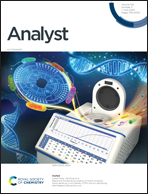A novel fluorescence method for the rapid and effective detection of Listeria monocytogenes using aptamer-conjugated magnetic nanoparticles and aggregation-induced emission dots†
Abstract
Fluorescence-based assays are efficient tools for the detection of Listeria monocytogenes (L. monocytogenes). However, they are always restricted by the phenomenon of aggregation-caused quenching (ACQ). The emergence of aggregation-induced emission (AIE) materials perfectly overcomes this shortcoming. Through harnessing the AIE characteristic with magnetic enrichment, we propose an approach to achieve a promising detection method that combines an aptamer and antibody-based dual recognition units. Aptamer-coupled magnetic beads were used for the specific capture of L. monocytogenes. IgG-TPE-OH@BSA NPs were facilely synthesized through encapsulating 1-(4-hydroxyphenyl)-1,2,2-triphenylethene (TPE-OH) in bovine serum albumin (BSA) microspheres, and possessed a bright fluorescence signal due to the aggregation of TPE-OH in BSA NPs. Rabbit immunoglobulin G (IgG) antibodies were labelled on the surface. In the detection system, the fluorescence intensity of the IgG-TPE-OH@BSA NPs in the supernatant was monitored to avoid the signal interference resulting from the deposit after magnetic separation. Using our strategy, the range of detection for L. monocytogenes is 10–106 cfu mL−1, and the detection limit is as low as 10 cfu mL−1 with a good selectivity. Upon analysis of spiked samples, the recoveries ranged from 95.37% to 101.90% without any pre-enrichment.



 Please wait while we load your content...
Please wait while we load your content...